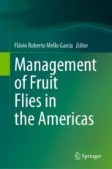Search
Search Results
-
Stable flies sense and behaviorally respond to the polarization of light
Insects use their polarization-sensitive photoreceptors in a variety of ecological contexts including host-foraging. Here, we investigated the effect...

-
kdr mutations and deltamethrin resistance in house flies in Abu Dhabi, UAE
BackgroundThe house fly, Musca domestica , is a significant carrier of diseases that can impact public health. Repeated use of pyrethroid...

-
True Flies: Diptera
The flies and midges within the order Diptera (true flies) bear membranous forewings, whilst their hindwings are vestigial, modified into balancing...
-
The species composition, richness and diversity studies of fruit flies captured from the orchard of Nagpur mandarin
The present experiment was conducted to study the diversity of fruit flies in Nagpur mandarin orchard from different agro-ecological zones of Vidarbha ...

-
Vimar/RAP1GDS1 promotes acceleration of brain aging after flies and mice reach middle age
Brain aging may accelerate after rodents reach middle age. However, the endogenous mediator that promotes this acceleration is unknown. We predict...

-
Biological Control of Fruit Flies with Emphasis on Microbial Control
The damage caused by fruit flies can occur directly through egg laying and larval development, which opens the door to secondary pathogens in the...
-
Acoustic Communication in Fruit Flies and Mosquitoes
Acoustic communication between conspecific males and females, mediated by wing movements, forms a key part of premating behavior in both fruit flies...
-
The Movement of Pathogen Carrying Flies at the Human–Wildlife Interface
Flies form high-density associations with human settlements and groups of nonhuman primates and are implicated in transmitting pathogens. We...

-
Locomotor Assays in Drosophila Larvae and Adult Flies
Brain defects often lead to motor dysfunctions in humans. Drosophila melanogaster has been one of the most useful organisms in the study of neuronal...
-
Neighbour adjusted dispersive flies optimization based deep hybrid sentiment analysis framework
A very crucial branch of Natural Language Processing is Sentiment Analysis, which seeks to elicit feelings in the public from feedback provided by...

-
Scuttle flies (Diptera: Phoridae) of subterranean habitats in Slovakia: a review and a case study
During biospeleological surveys in Slovakia in the past, phorid flies were usually overlooked or ignored. Only one species, Triphleba antricola ...

-
Molecular pathogen screening of louse flies (Diptera: Hippoboscidae) from domestic and wild ruminants in Austria
BackgroundHippoboscid flies (Diptera: Hippoboscidae), also known as louse flies or keds, are obligate blood-sucking ectoparasites of animals, and...

-
Fruit Flies: A Threat to Fruit Production in the Americas
This chapter briefly introduces the basics of fruit fly management in the Americas. A total of 21 species of fruit flies belonging to the genera...
-
Community composition of black flies during and after the 2020 vesicular stomatitis virus outbreak in Southern New Mexico, USA
BackgroundVesicular stomatitis virus (VSV), a vector-borne pathogen of livestock, emerges periodically in the western US. In New Mexico (NM), US,...

-
Zebras of all stripes repel biting flies at close range
The best-supported hypothesis for why zebras have stripes is that stripes repel biting flies. While this effect is well-established, the mechanism ...

-
Species Diversity of Anastrepha Fruit Flies (Diptera: Tephritidae) in Environments with Different Levels of Anthropogenic Changes
Studies on the diversity of Anastrepha species have been conducted mainly in agricultural orchards due to the economic importance of this insect...

-
Smelly interactions: host-borne volatile organic compounds triggering behavioural responses in mosquitoes, sand flies, and ticks
Volatile organic compounds (VOCs) are chemicals emitted as products of cell metabolism, which reflects the physiological and pathological conditions...

-
Differences in rectal amino acid levels determine bacteria-originated sex pheromone specificity in two closely related flies
Sex pheromones are widely used by insects as a reproductive isolating mechanism to attract conspecifics and repel heterospecifics. Although...

-
The Management of Fruit Flies in Colombia: A Long Road to Travel
Fruit production is an expanding sector within Colombian agriculture. There are numerous native and exotic fruit species produced both for the...
-
Fruit Flies (Diptera: Tephritoidea) and Parasitoids (Hymenoptera) Associated with Native Fruit Trees in the Chaco Biome
Fruit flies (Diptera: Tephritoidea) are the main pests over important fruits and vegetables. In this research was evaluated the tritrophic...

